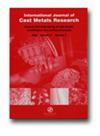热处理参数对Al-16Si-6Cu汽车换档叉组织、缺陷和性能的影响:定量评价视角
IF 1.1
4区 材料科学
Q3 METALLURGY & METALLURGICAL ENGINEERING
International Journal of Cast Metals Research
Pub Date : 2022-05-04
DOI:10.1080/13640461.2022.2082758
引用次数: 0
摘要
研究了固溶温度(STT)、淬火时间和淬火速率等热处理参数对Al-16Si-6Cu Shift - fork压铸合金显微组织、缺陷和硬度的影响。利用光学显微镜,结合图像分析和能谱扫描电镜,定量研究了初生硅颗粒(PSP)特征的变化。在470°C处理并在炉中冷却的样品溶液中,PSPs最大(27±8µm),面积分数最高(23%)。热处理后的硬度值略有升高(140 ~ 148 BHN)。较低的STT(420℃)和较短的时效时间(1 h)是Al-16Si-6Cu压铸合金热处理的适宜条件,可获得较低的孔面积分数(1.18),较小的孔(4.5 μm),较细的初晶硅(9.5±3 μm),较高的圆度(0.38±0.04)。本文章由计算机程序翻译,如有差异,请以英文原文为准。
Effect of heat treatment parameters on microstructure, defects, and properties of Al-16Si-6Cu automotive shift fork: quantitative evaluation perspective
ABSTRACT The current study investigated the effect of heat treatment parameters, including solution treatment temperature (STT), time, and quench rate, on the microstructure, defects, and hardness of an Al-16Si-6Cu Shift fork die-cast alloy. The changes in primary silicon particle (PSP) features were examined quantitatively by optical microscopy, coupled with image analysis and SEM equipped with EDS. The biggest PSPs (27 ± 8 µm) and the highest area fraction (23%) were found in the sample solution treated at 470°C and cooled in the furnace. The hardness value increased in heat-treated samples slightly (140–148 BHN). A lower STT (420°C) and a lower ageing time (1 h) are suitable conditions for the heat treatment of an Al-16Si-6Cu die-cast alloy, in which a lower pore area fraction, 1.18, smaller pore, 4.5 μm, along with finer primary silicon, 9.5 ± 3 μm, with higher circularity, 0.38 ± 0.04, was achieved.
求助全文
通过发布文献求助,成功后即可免费获取论文全文。
去求助
来源期刊
CiteScore
2.70
自引率
7.10%
发文量
14
审稿时长
7.5 months
期刊介绍:
The International Journal of Cast Metals Research is devoted to the dissemination of peer reviewed information on the science and engineering of cast metals, solidification and casting processes. Assured production of high integrity castings requires an integrated approach that optimises casting, mould and gating design; mould materials and binders; alloy composition and microstructure; metal melting, modification and handling; dimensional control; and finishing and post-treatment of the casting. The Journal reports advances in both the fundamental science and materials and production engineering contributing to the successful manufacture of fit for purpose castings.

 求助内容:
求助内容: 应助结果提醒方式:
应助结果提醒方式:


